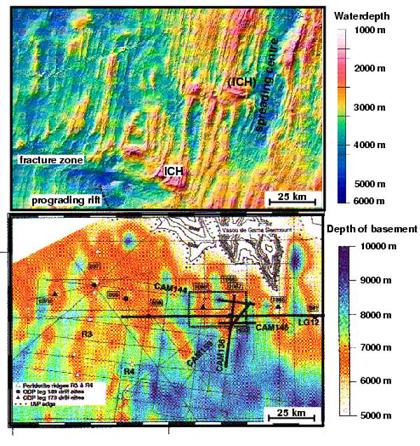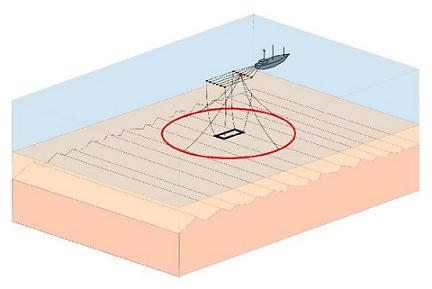We propose the development of "swath-seismics" using 9 parallel 9-channel streamers as an antenna to map out sub-surface geology at continental margins. As the width of each swath is approximately twice the water depth, the method can cover areas, several orders of magnitude more quickly than conventional mapping with grids of 2-D seismic lines or multistreamer near-vertical seismics (e.g. 3-D). Targets include tilted fault blocks, serpentinite ridges, the tops of lava flows, the top of the giant Gibraltar Olistostrome and the Bottom Simulating Reflector (BSR). The BSR is associated gas, which occurs at the base of gas hydrates. The method should also be able to image and map fields of diapirs and mud volcanoes. The versatility of the method gives it widespread and diverse application to European continental margins and their conjugates. Mapping of basement structure (faults blocks and lava flows) is particularly relevant for studies of rifting processes at both non-volcanic and volcanic continental margins. Mapping of BSRs and of mud volcanoes and other seeps and vents are essential for studying the fluid flow regime of the margin, and its linkages with the thermal regime, slope stability, neotectonics and gas hydrates. The proposal, thus, has relevance for all three main themes of the EUROMARGINS call for proposals.
SWATHSEIS Presentation
Motivation
The study of continental margins is based on the identification and interpretation of geological structures including fault blocks, lava flows, fluid conduits and mud diapirs. However, these structures are typically covered by sediment and difficult to detect.
In recent years bathymetric maps of mid-ocean ridges (Fig.1a) have shown in detail the three dimensional nature of the interaction of tectonic and magmatic processes. Large scale faulting at Inside Corner Highs (ICH), fault blocks and fracture zones are evidence of the complex tectono-magmatic interaction. However, similar maps are lacking at continental margins, because in most continental margins target structures are covered by a blanket of sediment that does not allow direct observation or mapping with multibeam bathymetry or side-scan sonar techniques. Mapping continental margin structures with 2-D seismic data is difficult because typically line spacing is too large to obtain their 3-D structure (compare Fig 1a and Fig 1b) and 3-D seismic data is too costly for most academic studies. Fig 1 shows an comparison of one of the best basement map published to date obtained from a grid of 2D seismic lines (bottom) with a a bathymetric map of a mid-ocean ridge from a comparable area. The difference in resolution, hence in detailed structures to be identified is some order of magnitudes. Yet, there is no reason to believe, that tectonic features and converging margins are any less complex than those at mid-ocean ridges.
 |
A method to produce large scale maps of geological features below the sediment cover in an efficeint and cost effective manner could greatly improve the understanding of the processes acting at continental margins.
Aims
The aim of the SWATHSEIS-Project is to develop an imaging method for sub-subsurface targets using a swath-seismic receiver array and a newly developed processing technique. The resolution of the bathymetric map shown in Fig 1a (top) of a mid-ocean ridge system is comparable to the resolution expected for the maps of subsurface structures produced with the swath-seismic method.
Method
The philosophy of the method is to use a seismic array of receivers to form an "antenna" which can discriminate the arrival of seismic energy by direction. This allows to discriminate reflection arrivals coming from below the acquisition system from back-scatter energy of prominent subsurface structures at oblique angles. With sophisticated data processing this can enable us to image prominent sub-surface structures (e.g. tilted fault blocks, serpentinite ridges, lava flows and prominent basement features covered by sediments). The swath-seismic antenna with about 2500m2 (red square) towed behind the research vessel is only a fraction of the size of a conventional 3D seismic streamer array of several km in length. Yet the covered subsurface area is much wider than the footprint of the 3D profile (black square).
 |
The principle of the swath-seismic method is related to swath-bathymetric mapping, hence the name, but it also has some fundamental differences. The common features include the high coverage of subsurface area with a single profile line. The swath-width, i.e. the width of the illuminated area below the ship is a factor of two for swath-seismic and up to eight times the water depth for the swath bathymetric method. This is an advantage compared to 3D seismic methods which cover only a width of half of the array size or vertical echo sounder and sub-bottom profilers which yield only a 2D line in profile direction.
Differences of the swath-seismic compared to swath-bathymetric imaging are that the latter uses a range of narrow focused beams emitted by the source. With the swath-seismic method we propose a omnidirectional (point) source and do the beam forming with the receiver antenna. Thus from each source location we obtain a full range of rays in azimuth and inclination directions. We use a 3D migration approach to stack the information from subsequent shot positions at the sub-surface location. This produces a large fold coverage and increases the signal-to-noise ratio compared to swath bathymetric or side-looking seismic methods.
Project Leader:
- CésarRaneroE-Mail
- University of KielGEOMAR Research Centre for Marine GeosciencesDepartment of Marine GeodynamicsKielGermany
Principal Investigators:
- RolfMjeldeE-Mail
- University of BergenDepartment of Earth ScienceBergenNorway
- LuisPinheiroE-Mail
- Universidade de AveiroDep. GeosciênciasAveiroPortugal
- GrahamWestbrookE-Mail
- University of BirminghamSchool of Geography, Earth and Environmental SciencesSubsurface Structure and Properties Research GroupBirminghamUnited Kingdom

